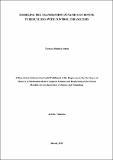| dc.description.abstract | Bovine tuberculosis (bTB) is a bacterial and zoonotic disease which is transmitted through;
consumption of unpasteurized milk, raw meat and inhalation of aerosols. This study used a
deterministic mathematical model to assess the impact of each parameter in the transmission
of bTB. The basic reproduction number R
computed to determine the behaviour of the disease.
The disease-free equilibrium exists and is locally asymptotically stable when R
0
< 1,
and it is unstable otherwise. However, there is a possibility for the diseases free equilibrium to
coexist with endemic equilibrium when R
= 1. The parameters which drive the dynamics of
bTB computed and sensitivity analysis performed. The analysis shows that the basic reproduction
number R
0
0
increases proportionally as the most positive sensitive parameters are increases.
However, the rate of animal deaths due to the disease mortality, the rate of natural animal deaths
and the rate of leaking for unused dairy products are conversely proportional to the basic reproduction
number R
. Numerical analysis performed to analyse how sensitive each parameter is
to the disease. Results show that bTB will increase when we increase rates of consuming dairy
products and contacts with infected humans and animals, respectively. The basic model then
extended by including control parameters to reduce bTB transmission. The effective reproduction
number R
e
0
decreases as we increase treatment of infected humans, quarantine of infected
animals and inspection of the dairy product. However, the standard requirement of effective
reproduction number Re to be less than a unit for the disease to clear is not enough because the
model undergoes backward bifurcation when R
= 1. Numerical analysis carried out to study
the long term behaviour of bTB. Simulations show that when control parameters increase, the
number of susceptible humans and animals increases, while the number of infected humans and
animals decreases. To contained Bovine tuberculosis, there should be the treatment of infected
humans, are quarantine of infected animals and dairy products should be inspected. | en_US |


